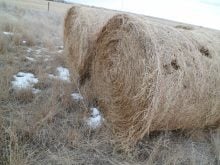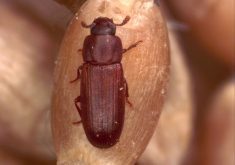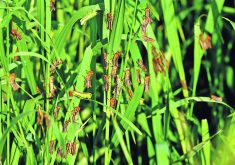Where they’re found
U.S. customs officials have discovered one of the world’s nastiest grain storage pests in a box crossing the border from Canada.
Officials at the Pembina port of entry in North Dakota found live khapra beetle larvae on the outside of a plastic bag of food items in a shipment declared as clothes and gifts being couriered from Canada to Houston, Texas.
The khapra beetle is one of the most destructive pests of stored grain and grain products, according to a document on the Canadian Food Inspection Agency’s website.
Read Also

Soybean market still figuring out implications of China-U.S. pact
Soybean futures had a muted reaction to the U.S. trade deal with China as the market tries to figure out the nuances of the deal.
“Currently the khapra beetle is not established in Canada. However, if it were introduced it could have severe adverse effects on our grain and oilseed industries, which are worth billions of dollars,” said the document.
The shipment was seized and destroyed by U.S. Customs and Border Protection to prevent infestation of the pest in that country.
A CFIA spokesperson was unavailable for comment, but the agency sent an e-mail response saying it was not known whether the shipment originated in Canada or from outside Canada and was being re-exported.
The International Union for Conservation of Nature said the khapra beetle is one of the world’s worst invasive species.
“The larvae are voracious eaters of grains, grain products and seeds, often leaving only the husk behind,” said the CFIA in its e-mail.
“Control of the pest is difficult because it is hard to detect and it is also resistant to many pest control products.”
It has been a regulated quarantine pest in Canada since 1968. International trade and travel has substantially contributed to the spread of the beetle.
“The pest has been intercepted in several imports to Canada in recent years and by the U.S. on shipments moving in transit via Canada or on product imported to Canada and re-exported to the U.S.,” said the CFIA in its e-mail.
In May, the CFIA notified the World Trade Organization of Canada’s intent to implement a phytosanitary certificate requirement on imports of agricultural seed and grain that certified the shipments are free from the khapra beetle.
The new requirements are planned for implementation Dec. 1.
Khapra beetle facts
- Native to India but have also been found in Africa, Asia, and parts of Europe and South America. In North America, the khapra beetle has been discovered in a few U.S. states but has been eradicated.
- Khapra beetles spread through the transportation of infested bagged cereals, grains or seeds. The beetle seeks food sources in bags, crates, rail cars, ship holds and trucks.
- An adult khapra beetle lives five to 10 days, but in that time one female beetle can lay 50 to 100 eggs. Larvae develop in four to six weeks. In optimal conditions up to 10 generations of beetles can develop in one year.
- An adult khapra beetle is about 1.6 to 3.0 mm long and is covered with hair. Males are brown to black with reddish-brown markings on their wings. Females are slightly larger than males, and lighter in colour.
- Khapra beetle larvae are yellowish white with brown hairs covering the head and body. They are about 1.6 to 1.9 mm long.
- Cast-off larval skins can cause skin irritation in people who handle heavily infested grains. In rare cases, the barbed hairs of the larvae can cause stomach irritation if swallowed.
















